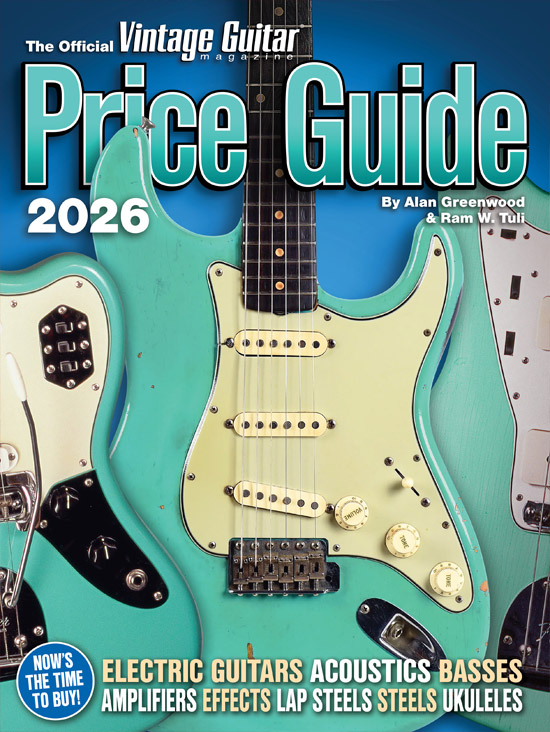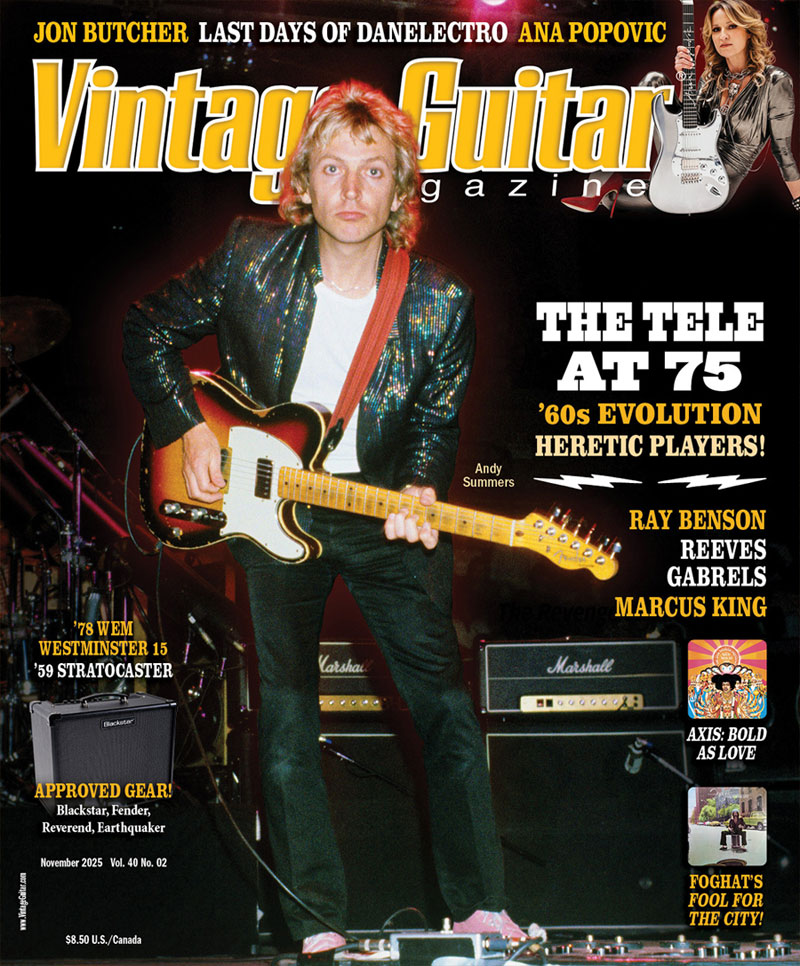
By integrating traditional blues with heavier, more flamboyant rock styles, Eric Sardinas has carved a raw, fiery sound, favoring electric and acoustic resonator guitars to deliver the appropriate vibe.
Growing up, Sardinas was exposed to everything from early Delta blues to Chicago blues to R&B, soul, and rock artists like Creedence Clearwater Revival, Chuck Berry, Led Zeppelin, and Jimi Hendrix.
“Basically, my influences come from anybody,” he said.
VG recently talked with Sardina s to discuss the making of his third disc, Black Pearls (Favored Nations), which was tracked live to analog tape and produced by the legendary Eddie Kramer.
Vintage Guitar: Who were your main influences, early on?
Eric Sardinas: I started playing when I was five or six, and was exposed to a lot of R&B, soul, and Motown music. I grew up listening to blues albums and buying blues records on my own, just out of the interest that I developed in blues.
I grew up playing those things and I just wanted to push it into a different genre. As far as being influenced, I think everybody you hear and listen to influences you. It’s a big well of music that shapes and molds the spirit of where you draw from and what you feel when you’re connecting with your instrument.
Had you started out playing slide?
Well, no. I didn’t start out playing slide. I started out with a nylon string acoustic guitar. I started playing slide in my early teens, probably at around 13. I bought my first resonator guitar in a pawn shop. It was about two-hundred dollars. I was a teenager and it seemed like a million dollars to me.
Which players were most inspirational as you began to shape your tone?
My tone is just my own thing. I drilled pickups into my guitar, and that’s my tone. I didn’t derive it from anything except a screwdriver and putting electronics into my guitar, which was a Dobro. I found an old lipstick-tube pickup and I just basically just cut a hole in the guitar where I thought the pickup would go, and put it in there.
Tell us about the material on Black Pearls. How did the songs come together?
The record came together by collecting what I was thinking, and putting lyrical ideas together with musical ideas I compiled.
I completed writing while working with Eddie Kramer, to see how we wanted to deliver the music. We agreed that the key is capturing the energy and magic, so that’s what we went for.
How did you hook up with Eddie?
I had him in mind because I heard my songs capturing the sort of energy you hear in the stuff he’s done with the Stones, the Beatles, and Zeppelin. It’s always got this really organic power to it and I really wanted the songs to breathe and be real. So I sent him the songs and we got in touch. He loved the music, and so we just started from there.
How did working with Eddie make this experience different from your previous recording work?
I really felt there was a mutual goal – to capture magic and let things be real – nothing else except creative. That allows you to do your best. We were on the same page, so it was nice.
What was your setup for the recording?
I used my custom Rivera amps and some vintage 4x12s, but most of it was through my custom-built Rivera head and Rivera 4x12s. I also had combinations with some ’60s Marshalls and stuff like that. I used my resonator guitars – my main two and a couple of steel-body guitars. I brought in a bunch just to have them around in case the spirit moved me for something else.
What do you use live?
It’s basically the same setup – the custom Riveras with a Rivera 4×12 and sub-bass cab. For guitars, I play the Washburn ES Cutaway and one of my older Dobros from [the early ’70s]. For effects, I have a wah and a Uni-Vibe.
I do have the vintage stuff, but onstage I’ve been using the Dunlop wah and Uni-Vibe, and the Dunlop Preaching Pipe – my signature slide, which is brass. I use .013-.058 Gibson phosphor bronze acoustic strings on all of my guitars, and I use Dunlop thumb picks.
Tell us about your signature model Washburns.
I’ve had my own guitars forever, just because I did them myself. And I’ve had other companies design outlines for what I want. I’ve been using alot of those guitars forever, but Washburn wanted to work with me [to] build a guitar. So we worked on the design. [I wanted it] to function in an electric format and in acoustic formats, so there are acoustic and electric versions. They’re two different body shapes and body styles, so the acoustics are different. But both have resonators, and they revolve around the same woods. One has a different barrel because of the shape of the body and its cutaway.
There are other aspects of the design that are different because there are certain things I thought were necessary for the electric; things like a reflective surface on the back of the resonator cone that helps project the sound out of the barrel. Plus, the cuts on the sound barrel of the electric are angled to project a little more, for greater contact with the pickup, as opposed to the more basic, straight-ahead acoustic.
Which of your personal guitars were they modeled after?
I created my own resonator, and I’ve got about 25 of them. So it stemmed from what I like in the shape of the body, the tones, and the woods. I prefer ebonies, and really basic ply bodies. I have tons of guitars that are so beautiful, but [looks are] unnecessary for tone. The cheaper it is, the better it sounds. I’m all about the runt of the litter when it comes to guitars.
Do you have a collection of vintage instruments?
I have many, and I really don’t delve into them as often as I’d like… unless I’m recording or writing. You can have 10 guitars that are exactly the same, from the same year, made one right after another, and none of them will sound exactly alike. They all have personalities, whether they’re steel bodies, or walnut, or flamed maple, or just traditional wood-body guitars. They’re all different and have great sounds.
So I love everything from my ’30s National tri-cones to the guitars I play onstage.
What advice can you offer to other guitarists on developing their style and tone?
If you love playing guitar, play it for yourself and be yourself. Write music and forge your own way, because you can do anything you want with it.
What advice can you offer on becoming a better songwriter?
I’m always growing and I’ve got a long way to go. I think it’s a real gift to be able to communicate an idea or a thought or a feeling, and transpose it into a song. There are a lot of elements that go into that.
Just keep those channels open, always write down your ideas, and try to write songs, no matter how bad they may be. You never know what might come out of it.
Photo courtesy Favored Nations.
This article originally appeared in VG‘s Feb ’04 issue. All copyrights are by the author and Vintage Guitar magazine. Unauthorized replication or use is strictly prohibited.



